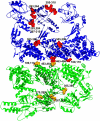Allosteric transitions in the chaperonin GroEL are captured by a dominant normal mode that is most robust to sequence variations
- PMID: 17557788
- PMCID: PMC1965427
- DOI: 10.1529/biophysj.107.105270
Allosteric transitions in the chaperonin GroEL are captured by a dominant normal mode that is most robust to sequence variations
Abstract
The Escherichia coli chaperonin GroEL, which helps proteins to fold, consists of two heptameric rings stacked back-to-back. During the reaction cycle GroEL undergoes a series of allosteric transitions triggered by ligand (substrate protein, ATP, and the cochaperonin GroES) binding. Based on an elastic network model of the bullet-shaped double-ring chaperonin GroEL-(ADP)(7)-GroES structure (R''T state), we perform a normal mode analysis to explore the energetically favorable collective motions encoded in the R''T structure. By comparing each normal mode with the observed conformational changes in the R''T --> TR'' transition, a single dominant normal mode provides a simple description of this highly intricate allosteric transition. A detailed analysis of this relatively high-frequency mode describes the structural and dynamic changes that underlie the positive intra-ring and negative inter-ring cooperativity. The dynamics embedded in the dominant mode entails highly concerted structural motions with approximate preservation of sevenfold symmetry within each ring and negatively correlated ones between the two rings. The dominant normal mode (in comparison with the other modes) is robust to parametric perturbations caused by sequence variations, which validates its functional importance. Response of the dominant mode to local changes that mimic mutations using the structural perturbation method technique leads to a wiring diagram that identifies a network of key residues that regulate the allosteric transitions. Many of these residues are located in intersubunit interfaces, and may therefore play a critical role in transmitting allosteric signals between subunits.
Figures





Similar articles
-
Allostery wiring diagrams in the transitions that drive the GroEL reaction cycle.J Mol Biol. 2009 Mar 27;387(2):390-406. doi: 10.1016/j.jmb.2008.12.032. Epub 2008 Dec 24. J Mol Biol. 2009. PMID: 19121324
-
Effective ATPase activity and moderate chaperonin-cochaperonin interaction are important for the functional single-ring chaperonin system.Biochem Biophys Res Commun. 2015 Oct 9;466(1):15-20. doi: 10.1016/j.bbrc.2015.08.034. Epub 2015 Aug 11. Biochem Biophys Res Commun. 2015. PMID: 26271593
-
A dynamic model of long-range conformational adaptations triggered by nucleotide binding in GroEL-GroES.Proteins. 2012 Oct;80(10):2333-46. doi: 10.1002/prot.24113. Epub 2012 Jul 6. Proteins. 2012. PMID: 22576372
-
Signalling networks and dynamics of allosteric transitions in bacterial chaperonin GroEL: implications for iterative annealing of misfolded proteins.Philos Trans R Soc Lond B Biol Sci. 2018 Jun 19;373(1749):20170182. doi: 10.1098/rstb.2017.0182. Philos Trans R Soc Lond B Biol Sci. 2018. PMID: 29735736 Free PMC article. Review.
-
Chaperonin-mediated protein folding.Annu Rev Biophys Biomol Struct. 2001;30:245-69. doi: 10.1146/annurev.biophys.30.1.245. Annu Rev Biophys Biomol Struct. 2001. PMID: 11340060 Review.
Cited by
-
Conformational dynamics of nonsynonymous variants at protein interfaces reveals disease association.Proteins. 2015 Mar;83(3):428-35. doi: 10.1002/prot.24748. Epub 2015 Jan 13. Proteins. 2015. PMID: 25546381 Free PMC article.
-
A phylogenetic analysis of normal modes evolution in enzymes and its relationship to enzyme function.J Mol Biol. 2012 Sep 21;422(3):442-59. doi: 10.1016/j.jmb.2012.05.028. Epub 2012 May 28. J Mol Biol. 2012. PMID: 22651983 Free PMC article.
-
Normal Mode Analysis as a Routine Part of a Structural Investigation.Molecules. 2019 Sep 10;24(18):3293. doi: 10.3390/molecules24183293. Molecules. 2019. PMID: 31510014 Free PMC article. Review.
-
The 'allosteron' model for entropic allostery of self-assembly.Philos Trans R Soc Lond B Biol Sci. 2018 Jun 19;373(1749):20170186. doi: 10.1098/rstb.2017.0186. Philos Trans R Soc Lond B Biol Sci. 2018. PMID: 29735739 Free PMC article.
-
Perturbation-based Markovian transmission model for probing allosteric dynamics of large macromolecular assembling: a study of GroEL-GroES.PLoS Comput Biol. 2009 Oct;5(10):e1000526. doi: 10.1371/journal.pcbi.1000526. Epub 2009 Oct 2. PLoS Comput Biol. 2009. PMID: 19798437 Free PMC article.
References
-
- Sigler, P. B., Z. Xu, H. S. Rye, S. G. Burston, W. A. Fenton, and A. L. Horwich. 1998. Structure and function in GroEL-mediated protein folding. Annu. Rev. Biochem. 67:581–608. - PubMed
-
- Swain, J. F., and L. M. Gierasch. 2006. The changing landscape of protein allostery. Curr. Opin. Struct. Biol. 16:102–108. - PubMed
-
- Thirumalai, D., and G. H. Lorimer. 2001. Chaperonin-mediated protein folding. Annu. Rev. Biophys. Biomol. Struct. 30:245–269. - PubMed
-
- Horovitz, A., Y. Fridmann, G. Kafri, and O. Yifrach. 2001. Review: allostery in chaperonins. J. Struct. Biol. 135:104–114. - PubMed
Publication types
MeSH terms
Substances
Grants and funding
LinkOut - more resources
Full Text Sources
Research Materials

